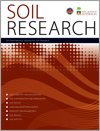Over the past 25 years, considerable energy, time, and money has been devoted to the research, development and operational implementation of Digital Soil Mapping (DSM) in Australia. The continual evolution of DSM methods over time have led to a lack of operational stability that creates an ongoing risk associated with the method. A more objective analysis and review is required on the merits of DSM and where the pedometric toolkit can answer the most important soil-related questions in Australia.
SR22042 Abstract | SR22042 Full Text | SR22042PDF (645 KB) Open Access Article





